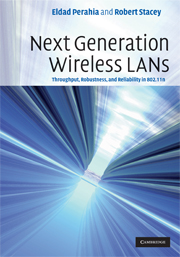Book contents
- Frontmatter
- Contents
- Foreword by Dr. Andrew Myles
- Preface
- List of abbreviations
- 1 Introduction
- Part I Physical layer
- Part II Medium access control layer
- 7 Medium access control
- 8 MAC throughput enhancements
- 9 Advanced channel access techniques
- 10 Interoperability and coexistence
- 11 MAC frame formats
- Part III Transmit beamforming
- Index
- References
11 - MAC frame formats
from Part II - Medium access control layer
Published online by Cambridge University Press: 04 December 2009
- Frontmatter
- Contents
- Foreword by Dr. Andrew Myles
- Preface
- List of abbreviations
- 1 Introduction
- Part I Physical layer
- Part II Medium access control layer
- 7 Medium access control
- 8 MAC throughput enhancements
- 9 Advanced channel access techniques
- 10 Interoperability and coexistence
- 11 MAC frame formats
- Part III Transmit beamforming
- Index
- References
Summary
This section provides details on the MAC frame formats. The information provided here is sufficiently detailed to act as a reference for the topics discussed in this book, but it does not provide an exhaustive list of all field elements, particularly in the management frames. For a detailed treatment of the frame formats refer to the actual specification (IEEE 2007a, 2007b).
General frame format
Each MAC frame consists of the following:
a MAC header
a variable length frame body that contains information specific to the frame type or subtype
a frame check sequence or FCS that contains a 32-bit CRC.
This frame format consists of a set of fields that occur in a fixed order as illustrated in Figure 11.1. Not all fields are present in all frame types.
Frame Control field
The Frame Control field is shown in Figure 11.2 and is composed of a number of subfields described below.
Protocol Version field
This field is 2 bits in length and is set to 0. The protocol version will only be changed when a fundamental incompatibility exists between a new revision and the prior edition of the standard, which to date has not happened.
Type and Subtype fields
The Type and Subtype fields together identify the function of the frame. There are three frame types defined: control, data, and management. Each frame type has several subtypes defined and the combinations are listed in Table 11.1.
Information
- Type
- Chapter
- Information
- Next Generation Wireless LANsThroughput, Robustness, and Reliability in 802.11n, pp. 266 - 304Publisher: Cambridge University PressPrint publication year: 2008
